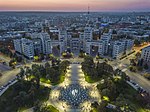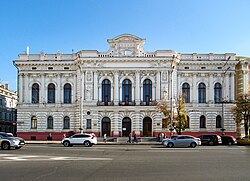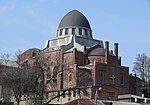Mirror Stream

Mirror Stream (Ukrainian: Дзеркальний струмінь, Dzerkalʹnyi struminʹ; Russian: Зеркальная струя, Zerkalʹnaya struya) is a fountain in Kharkiv, Ukraine. The natural fountain was discovered in 1947.The fountain is near the Kharkiv Philharmonic. It was built in 1947. It remains one of the most remarkable architectural monuments in Kharkiv and, due to that, has been listed in UNESCO's Encyclopedia. A "Komsomol Heroes Alley" with busts of young World War II heroes was located behind the fountain from 1958 until 2013. The busts were removed during the construction of the new church Khram Svyatykh Zhon-Myronosytsʹ, due to the 2015 decommunization laws they have never returned.
Excerpt from the Wikipedia article Mirror Stream (License: CC BY-SA 3.0, Authors, Images).Mirror Stream
Skrypnika Street, Kharkiv Нагорний
Geographical coordinates (GPS) Address External links Nearby Places Show on map
Geographical coordinates (GPS)
| Latitude | Longitude |
|---|---|
| N 49.998611111111 ° | E 36.234722222222 ° |
Address
Дзеркальний струмінь
Skrypnika Street
61057 Kharkiv, Нагорний
Kharkiv Oblast, Ukraine
Open on Google Maps







